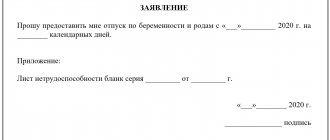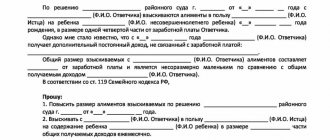Collection of alimony in a fixed amount through the court
That is why the most pressing problems include the collection of alimony payments for children, the collection of alimony for a spouse up to 3 years of age of the child. Women face this problem everywhere, and even a very wealthy person can be a persistent defaulter.
But it is not yet possible to find out the real income of defaulters, because in our time any person can have several sources of income. There is also no practice of seizing the property of an alimony debtor. And the search procedure itself, both sources of income and property, is usually carried out by the claimant himself. Hence the problems with collection, which give rise to an irresponsible attitude towards alimony payments. A statement of claim for the recovery of alimony in a fixed amount will solve the problem.
USEFUL: watch the video with advice from a lawyer on alimony, write your question in the comments of the video
There are two types of alimony payments:
- collection of alimony in a fixed sum of money,
- payment of a percentage determined by law on all types of income.
Alimony is paid to children in a fixed amount, usually in cases where the person obligated to make payments has irregular income, or if his income is calculated in foreign currency; in addition, this type of alimony applies to those parents whose income is absent or impossible to collect. The practice of collecting alimony in a fixed monetary amount varies, and often happens without the involvement of a professional and cannot be sorted out. That is why it is beneficial to contact us for legal assistance.
Also, alimony can be regular, which is paid every month, and one-time, when payments are established in connection with additional expenses.
The amount of alimony is determined both by a court decision and by agreement of the parties.
Grounds for assigning alimony in a fixed amount
In order to collect alimony in a fixed amount, certain conditions are necessary, namely, that the parent from whom it is required to collect alimony in a fixed amount:
- had irregular earnings that are constantly changing, or any other irregular income;
- received earnings or other income not only in monetary terms in rubles, but also in kind or in foreign currency. Moreover, the parent may receive such income in whole or in part in kind or in foreign currency;
- had no earnings or income at all;
- received income, but at the same time collecting alimony from him in the amount of a share of the income is impossible, or very difficult, or such collection significantly violates the interests of one party;
- was better off than the other parent, and the children remained with each parent, i.e. the parent who is more wealthy pays alimony in a fixed amount in the interests of the child living with the less wealthy parent.
The main purpose of collecting alimony in a fixed amount is to preserve the child’s previous standard of living as much as possible.
Grounds for receiving alimony in the form of a fixed amount
As a general rule, maintenance in a certain amount is calculated in relation to adult, adult family members. This could be elderly parents, a disabled spouse, or a disabled adult child. But even in the case of assigning payments for the maintenance of common children until they reach adulthood, this method of determining their size can be used.
Child support is awarded in a fixed amount if the parent:
- does not have official employment;
- receives income depending on the season;
- at least part of the earnings is received in foreign currency or in kind (goods).
Another reason may be that the amount of earnings is such that paying a share of it according to the law will cause a sharp deterioration in the child’s situation. It is precisely this fact that the judge should focus on when filing an application for the collection of alimony in a fixed amount.
A prerequisite for requesting alimony through the court is the absence of a valid alimony agreement between the parents. This document, signed by a notary, has the same force as a judicial act. Therefore, if it exists, the claim on the same basis is not considered.
How to calculate alimony in a fixed amount?
When calculating alimony in a fixed monetary amount, it is necessary to justify the appropriate amount of alimony, i.e. confirm that, for example, before the dissolution of the marriage between the parents, such and such an amount of money was used to support the child, such and such an amount was spent on the child’s attendance at classes, etc., in connection with which, in order to ensure the child’s maintenance previous standard of living, it is necessary to collect alimony from the defendant in a fixed amount. Also, in support of his arguments, the plaintiff must provide receipts, checks, and other documents confirming what amounts are spent to provide for the child.
ATTENTION : do not forget about the grounds for collecting alimony in a fixed fixed amount.
Indexing
Payment of alimony is a long-term obligation, the period of which is usually calculated in years. During this period, prices regularly rise and inflation gradually depreciates the alimony payment assigned in a fixed amount.
The law provides for a procedure for indexing alimony payments (Article 117 of the RF IC) to maintain them at the level of rising prices for consumer goods and services. Only payments paid in a fixed amount of money are subject to indexation, because alimony, levied as a percentage of income, implies a gradual increase along with the income itself.
For payments in a fixed amount paid under a voluntary alimony agreement, the indexation procedure may be specified in the agreement itself. If it is not reflected in the agreement, then indexation is carried out in accordance with current legislation, as for alimony ordered by the court.
The revision of alimony payments, established in a fixed amount, is carried out in accordance with the increase in the cost of living for children, which is separately established every quarter in each region of the Russian Federation. Therefore, a common practice when a court assigns alimony in a fixed form is to link the amount of payment to the amount of the subsistence minimum.
Recipients of alimony should be aware that not only the payment amount itself is subject to regular indexation, but also possible alimony debt, since the formation of long-term debt is a fairly common situation.
Indexation of the accumulated debt for alimony payments is the responsibility of the bailiff involved in debt collection.
Indexing example
Dmitry N. is obliged by the court to pay monthly child support in a fixed amount. When the court made a decision on the payment of alimony, the amount of the regular payment was 7,000 rubles, and the child's subsistence level in the constituent entity of the Russian Federation where the recipient and the defendant live was 9,500 rubles.
In fact, the payment assigned in a fixed amount amounted to 74% of the regional subsistence level per child. In the next quarter, the cost of living for children in this region was increased to 10,000 rubles.
The indexation of the alimony payment in favor of the child Dmitry N. in accordance with the increase in the cost of living should be determined as follows: (7000 / 9500) × 10000 = 7368 rubles.
In this case:
- 7000 rub. - the amount of a fixed alimony payment established by a court decision;
- 9500 rub. — regional indicator of the cost of living per child when payments are ordered by the court;
- 10,000 rub. — children’s subsistence level increased in the next quarter;
- 7368 rub. — the amount of the indexed alimony payment.
The concept of “indexation” means a kind of protection of a fixed amount of alimony from rising consumer prices for goods and services. Since alimony is a long-term payment and prices are constantly rising, a fixed fixed amount would periodically lag behind price increases and eventually become insignificant.
Art. 117 of the RF IC provides for the indexation of alimony collected in the TDS in proportion to the increase in the subsistence minimum (ML) per child in the region of his residence, and if one has not been established for the region, in proportion to the increase in the LLM value in the whole of the Russian Federation.
It is necessary to take into account that when the monthly minimum is reduced, the amount of alimony remains unchanged (clause 5.2 of the “Methodological recommendations on the procedure for fulfilling the requirements of executive documents on the collection of alimony dated June 19, 2012 No. 01-16, hereinafter “Methodological recommendations...”).
Indexation for alimony collected as a share of the payer’s income is not provided because wages in accordance with Art. 134 of the Labor Code of the Russian Federation must be indexed by the employer, and the amount of payments, therefore, will increase with its increase.
(Fixed amount of alimony / Current PM) × Changed PM = Alimony after indexation
Example. Alimony in the amount of 5,000 rubles was collected from Ivan M. The cost of living when assigning funds for a child was 9,500 rubles in the collection region. After some time, the minimum monthly allowance for a child increased to 10,000 rubles, therefore, the indexation of alimony from Ivan should be calculated as follows:
We invite you to read: Purpose of payment when transferring alimony
(5000 / 9500) × 10000 = 5263 rub.,
Where:
- 5000 – TDS established by the court;
- 9500 – previous monthly allowance per child;
- 10,000 – newly established PM per child;
- 5263 – the amount of alimony in the TDS after indexation.
The payer must transfer the indexed amount of funds before a new increase in the PM.
The responsibility for indexing alimony rests with the employer and (or) the bailiff. If the recoverer of funds notices the lack of indexation of payments received, he has the right to contact the bailiff with a request to carry it out in accordance with Art. 117 RF IC, Art. 50 Federal Law No. 229 “On Enforcement Proceedings”.
What documents are needed to submit an application for the collection of alimony in a fixed amount?
To file a claim for alimony, you will need the following documents, copies of which must be attached to the claim:
- ♦ certificate of marriage or divorce;
- ♦ child’s birth certificate;
- ♦ documents confirming that the child lives with the plaintiff, this could be a certificate from the management company, a court decision to determine the child’s place of residence with the plaintiff;
- ♦ documents that confirm the plaintiff’s income and expenses, in particular expenses for the child associated with his maintenance, attendance at clubs, etc.;
- ♦ if there is information about the defendant’s income, then copies of the relevant documents must be attached;
- ♦ documents that confirm the level of support for the child before a dispute arises between the parents regarding the maintenance of the child and the payment of alimony.
If the plaintiff does not have any documents, he can file a petition with the court to request certain documents, but it is necessary to attach copies of evidence confirming that the plaintiff independently tried to obtain the relevant documents, i.e. it is necessary to attach copies of requests that the plaintiff sent to certain bodies (organizations) to obtain documents.
How to cancel alimony in a fixed amount?
If the court of first instance has collected alimony from the defendant in a fixed sum of money, then the defendant has the right to appeal the court decision within the prescribed period.
If for a certain time the defendant paid alimony in a fixed amount by court decision, but the circumstances that served as the basis for collecting alimony in a fixed amount have changed, in this case the alimony payer can apply to the court with a claim to change the amount of alimony established by the court, since the grounds for the collection of alimony in a fixed amount are not available at the time of filing such a claim, i.e., for example, the plaintiff (the defendant in the claim for the collection of alimony in a fixed amount) has a permanent job with a constant income.
The procedure for withholding under a writ of execution
Funds for child support in a fixed amount can be assigned for payment in two ways:
- voluntarily - by concluding an alimony agreement with a notary;
- in a compulsory judicial procedure - by applying to the magistrate's court with an application for the recovery of funds.
Going to court is inevitable if the second parent refuses to provide financial support for the child or does not agree to conclude a notarial alimony agreement. It does not matter whether the parent has an income, is unemployed or has a disability group - funds for the maintenance of the child will be assigned by the court, and their size will depend, among other things, on the level of income of the future payer.
Conditions for concluding a voluntary notarial agreement:
- There must be full agreement between father and mother on all aspects of child support payments:
- according to the size of the fixed amount;
- method of crediting (transferring) funds;
- the procedure for indexing payments;
- responsibility of the parties.
the timing of its payment;
Procedure for concluding an agreement:
- the mother and father of the child visit the notary together;
- The following documents are required to complete the procedure:
- passports of the parties;
- certificate of salary of the future payer.
child’s birth certificate (if a child is born out of wedlock, a document confirming paternity);
If the child has reached the age of 14, his personal presence at the notary is mandatory. If one of the parents is unable to be present with the specialist, his authority can be represented by another person under a notarized power of attorney.
A notarial agreement is issued on a special form on the day of its conclusion, is endowed with the legal force of a writ of execution (Part 2 of Article 100 of the RF IC), and as a result of non-fulfillment of its terms, the original can be transferred to the debtor’s workplace or to the bailiff service department for enforcement. .
It is impossible to collect alimony in a fixed amount using a court order, since a meeting is necessary to accurately determine the amount to be paid. That is why in this case it is necessary to go to court with a statement of claim.
A statement of claim for alimony in the TDS is submitted to the magistrate's court at the place of residence of either the plaintiff or the defendant (whichever is more convenient for the applicant) and contains:
- The introductory part (or “header” of the claim), which indicates:
- name of the court and address of its location;
- plaintiff, his full name, address, contact phone number;
- the defendant and the same information about him.
- Title: “Statement of claim for the assignment of alimony in a fixed sum of money in accordance with Art. 83 IC RF".
- The main part, which reflects:
- brief information about the situation (information about family, divorce, separation);
- lack of financial participation from the legal parent in the child’s life;
- a description of the child’s need for alimony in a fixed amount, indicating the choice of this method of collecting funds, that is, one of the grounds of Art. 83 RF IC;
- justification for the required amount of TDS, that is, providing the court with information about the monthly expenses for the child, attaching checks, receipts, and other evidence.
- The claim is the recovery of alimony from the defendant in TDS (specify the amount) on the basis of Art. 80, 81, 83 RF IC.
- List of attached documents (submitted according to the number of persons participating in the case. In this case, in two copies - for the court and the defendant):
- a copy of the plaintiff's passport;
- a copy of the child's birth certificate;
- certificate of family composition;
- certificate from the plaintiff’s place of work (if available);
- certificate of employment of the child (if employed - school, kindergarten);
- documents confirming additional expenses for the child (certificates of attendance at additional education institutions, checks, receipts, contracts, etc.);
- other documents (which, in the plaintiff’s opinion, are important for the case).
The result of the court hearing is a court decision to collect alimony in a fixed amount and an additional document - a writ of execution.
The writ of execution states exactly the following in accordance with the court decision:
- FULL NAME. future payer;
- the amount of mandatory alimony;
- The term for payment of funds is until the child comes of age.
After the court decision enters into legal force, the plaintiff can pick up the writ of execution from the judicial assistant and present it to the territorial department of the bailiff service to initiate alimony enforcement proceedings (IP).
After the initiation of the IP, the bailiff begins to work with the payer: he notifies the parent about the existence of a monetary obligation and monitors its implementation.
If the payer is not employed or is engaged in entrepreneurial activity and it is impossible to send a writ of execution to the alimony payer’s workplace (since it is absent), then the bailiff and the collector himself are required to control the transfer of funds. If payments begin to fall behind, the recipient is obliged to notify the bailiff about this in order to monitor the alimony debt and apply the full possible range of measures to the debtor to motivate its repayment.
We suggest you read: Where is a child registered at birth if the parents have different registrations?
Alimony is calculated in a fixed amount depending on the minimum subsistence level of the minor in the region of his residence. If current data on this indicator is not available, the calculation is made based on the average data for the country.
The amount of alimony may be less or more than the minimum subsistence level. It may differ from the amount the child receives in child support, calculated as a share of earnings.










